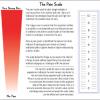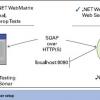|
|
Got You Covered Excellent testing starts by questioning the mission. So, the first step when we are seeking to evaluate or enhance the quality of our test coverage is to determine for whom or what we're determining coverage.
|
|
|
|
Transforming Your Test Culture: One Step at a Time Whether we develop software-based systems to create invoices, solve difficult physics problems, diagnose heart disease, or launch rockets, we've learned that nothing stays the same very long and software defects are inevitable. However, one thing has remained constant—the role and value of testing has been misunderstood by many in senior management. A Lockheed Martin Fellow since 2005, Tom Wissink describes steps undertaken at Lockheed Martin to change this culture of misunderstanding into a culture of appreciation, satisfaction, and excitement. Tom's experience has convinced him that this change is not just theoretical but both possible and rewarding. In a few organizations, both large and small, this has resulted in dramatic changes including greater tester satisfaction, increased company profits, and improved software quality often delivered on time and within budget.
|
Thomas Wissink, LM IS&S
|
|
|
It's in the Way That You Use It Rapid testers don't think of test automation merely as something that controls a program and checks for some expected result. Instead, we think of test automation as any use of tools to support testing. With that definition in mind, it may not be the most obvious automation tool that is the most useful.
|
|
|
|
Know Where Your Wheels Are Drawing from his experiences while learning to drive, Michael applies lessons he learned from written rules, experiential learning, and the advice of mentors to teaching new testers some valuable skills.
|
|
 |
It's a Bug! Bug triage, like labor and delivery triage, is about deciding a course of action on the spot, often with minimal information guiding decision making. Discover what other lessons Robert has learned from Anne's experience in nursing that have practical applications in his hunt for bugs.
|
|
|
|
Out of the Rut Are you bored? Do feel as if all you do is repeat heavily scripted tests and as a result you aren't learning, discovering new problems, or finding bugs? These nine heuristics can help you get out of your rut and take back control of your testing process.
|
|
|
|
How Much Is Enough?—Exploring Exploratory Software Testing Exploratory testers design and execute tests in the moment, starting with an open mission and investigating new ideas as they arise. But how do we know when to stop? The first step is to recognize that we can't know when we're done, because any approach to answering the stopping question is necessarily heuristic.
|
|
 |
Breaking Ground on SOA: How to Build and Test Your First Web Service Web services are the foundation of today's service-oriented architecture. This article will teach you how to build a Web service from the ground up as well as how to test it using the three pillars of Web services testing—functional, performance, and interoperability tests.
|
|
|
|
McLuhan for Testers If a tester is "somebody who knows that things can be different," then Marshall McLuhan was a tester par excellence. According to McLuhan, the English professor who proposed the Laws of Media, the message of a medium is not its content but rather its effects. Find out how this translates to software testing and how we evaluate requirements.
|
|
|
|
How to Design Frustrating Products In the software business, poor product design can lead to frustration and wasted time for our customers. Although we can ignore "usability" and "good design" without negatively impacting the initial success of a product, sales and customer satisfaction will suffer in the long run. Usability is a topic that has been discussed at great length, but many of the accepted design conventions either lack explanations of where and how to apply them, or they are entirely untrue. Sanjeev Verma explains how to ignore usability and save valuable time during the design phase of a product and apply it where it really counts-on new feature development. Kendra Yourtee offers proven practices that she has used in her daily routines to improve the usability of products as they are updated. She discusses simple ways to "test" designs against real data before the software is complete.
|
Sanjeev Verma, Microsoft
|





